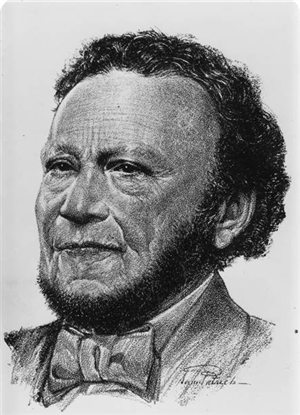In November 1845, George (1790?-1863) and Isabella James (c. 1809-1866) Bush and their five sons settle near Tumwater on a fertile plain that comes to be known as Bush Prairie. They and their party, which includes their good friend Michael T. Simmons (1814-1867) are the first Americans to settle north of the Columbia River in what is now Washington. The Simmons party makes the historically significant decision to settle north of the Columbia primarily because the discriminatory laws of the provisional government of Oregon Territory prohibit George Bush, an African American who is a key leader of the group, from settling south of the river.
George Bush, an experienced frontiersman and successful farmer, was one of the wealthier pioneers to follow the Oregon Trail west. His father, of African descent, was said to be a sailor, and his mother was an Irish American servant. As a young man, Bush worked as a voyageur and trapper for fur trading companies, including the famed Hudson's Bay Company (HBC). During this time he traveled extensively in the Western plains and mountains, perhaps reaching Puget Sound.
Seeking Freedom in the West
By the 1830s, Bush had settled in Missouri and married Isabella (or Isabell) James , a young German American woman with whom he had five sons (a sixth was born in the West). Bush farmed and raised cattle, and the family was well off. However, Missouri, a slave state, had passed racial exclusion laws, and Bush and his sons faced increasing bigotry and discrimination. In an effort to escape the discrimination, the Bushes joined the family of their friend Michael Simmons, a white Kentuckian, and three other white families related to the Simmons, to head west on the Oregon Trail. Bush's frontier experience made him a valuable addition to the party.
When the Simmons party reached the Columbia River in the fall of 1844, they found that the provisional government of Oregon Territory had enacted discriminatory laws, like those of Missouri, barring settlement by African Americans. Not wishing to separate from the Bush family, Simmons and the other members of the party decided to locate north of the Columbia, where American settlers and their provisional government had not yet extended their reach. The party spent the winter of 1844-45 on the Columbia, not far from Hudson's Bay Company's Fort Vancouver in present-day Clark County.
The New Settlement
In 1845, Simmons led an exploration around Puget Sound, and ultimately decided to settle at the head of Budd Inlet in what is now Thurston County. In October 1845, the entire party set off from Fort Vancouver down the Columbia River to the Cowlitz, and up that river to Cowlitz landing. From there they spent 15 days making a road through the forest to Budd Inlet, where Simmons established a settlement he called New Market, which later became Tumwater.
In early November 1845, George and Isabella Bush and their sons settled nearby, on a fertile prairie that soon took their name. The family began a farm, using seeds they had carried with them, that soon became the most productive in the region. Within a few years Simmons and Bush had set up a sawmill and a gristmill near their claims.
As more settlers poured into the region, Bush became famous for his generosity. From his stores of grain, he provided newcomers, sometimes half-starved from the journey, food for their first winter and seed to start their farms, asking no payment other than to return, when they could, the amount they took. Bush was also known for his friendly relations with and influence among the Indians of the region.
Discrimination and Exception
Ironically, the discriminatory laws the Bushes were trying to avoid had followed them, at least in part due to their own pioneering efforts. The 1845 American settlement north of the Columbia was one of the catalysts for the 1846 Treaty of Oregon, which resolved the U.S.-British boundary dispute by giving the territory south of the 49th parallel to the U.S., thus bringing what is now Washington under the discriminatory law of Oregon Territory. As a result, Bush did not have a clear legal claim on the 640 acres he and his family had painstakingly cultivated.
When Washington Territory was organized in 1853, many of the new legislators were friends and neighbors of the Bush family and beneficiaries of their generosity. Although this experience did not necessarily make them less prejudiced, it did inspire them to make an exception for George Bush and his sons. The first territorial legislature voted unanimously for a resolution urging Congress to pass a special act confirming George and Isabella Bush's title to the land they had claimed and farmed. Congress did so in 1855, and the Bush Prairie farm remained in the hands of the Bush family for generations.
George Bush died on April 5, 1863, and Isabella Bush died on September 12, 1866. Several of their sons went on to play active roles in Thurston county civic and political affairs. The eldest, William Owen Bush, was a member of the first state legislature in 1889-1890 and an award-winning farmer who worked the Bush Prairie farm until his death in 1907.
In 1973, acclaimed artist Jacob Lawrence (1917-2000), a Washington state resident since 1971, painted a series of five paintings depicting George Bush's journey by wagon train across the continent from Missouri to Bush Prairie. The series is in the collection of the Washington State Capitol Museum.

